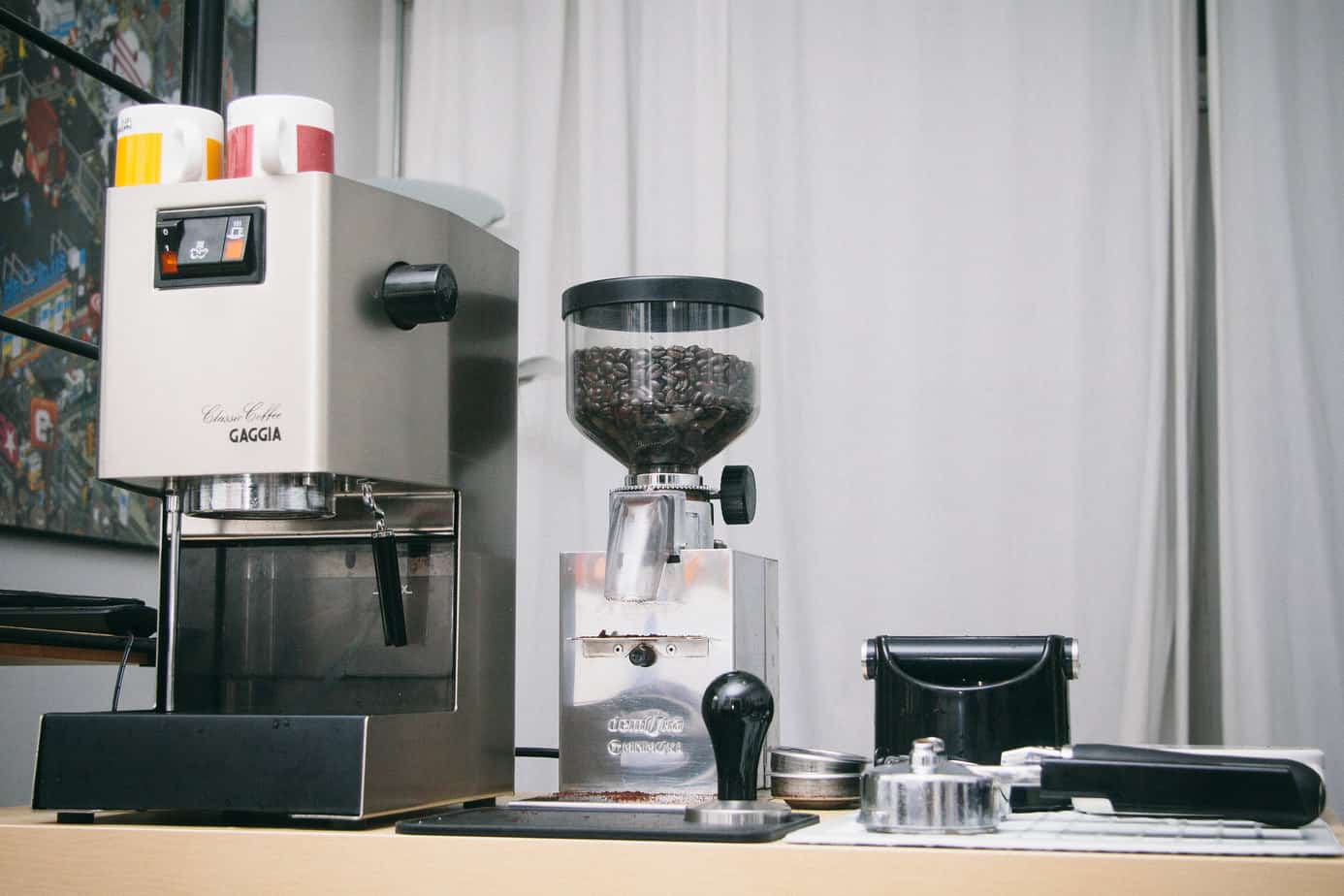Just so you know, as an Amazon Associate we earn from qualifying purchases made via bold red links, buttons or images.
Last Updated on December 15, 2023
Espresso might seem like the kind of drink you only buy at the coffee shop, but this doesn’t have to be the case.
The two biggest barriers to making espresso yourself are cost and expertise. You need a fairly complex machine to make espresso, and you need to know what you’re doing.
When it comes to cost, the good news is that espresso makers come in a wide range of prices, as you’ll see below in our list of the best espresso machines for beginners. You can even buy one for as little as $100, although most will be more expensive than that.
Then there’s the expertise hurdle. It can be daunting to watch a barista brew up an espresso, and indeed it takes some know-how. But that’s also the beauty of the espresso-making process.
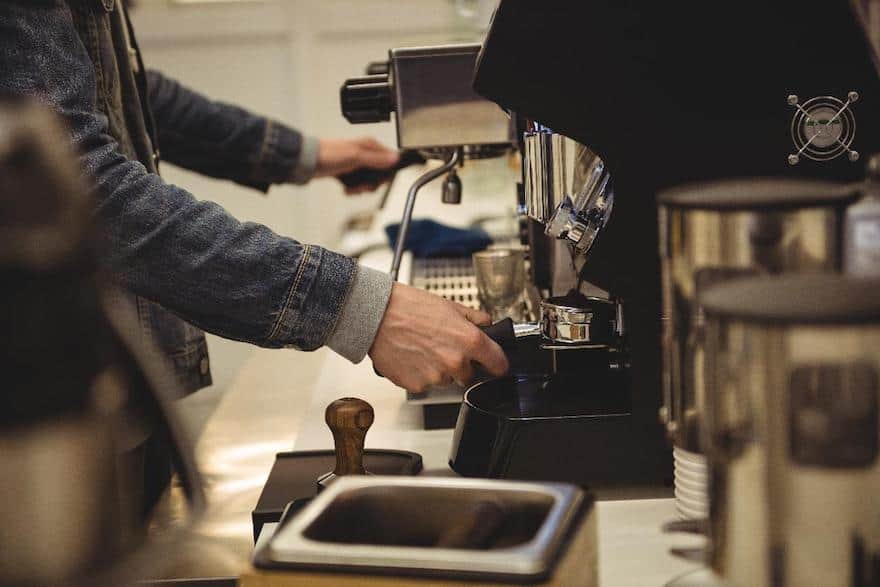
Learning the art of espresso-making, and then being able to produce a finely crafted shot of espresso on demand in your own home, is a distinct pleasure. You won’t go from novice to expert overnight, but the journey of getting into coffee and learning how to make espresso is worthwhile for the true coffee lover.
Best espresso machine for beginners at five price points
- Budget: De’Longhi EC155
- Affordable: Mr. Coffee Café Barista
- Mid-range: Breville Bambino Plus
- Upmarket: Gaggia Classic Pro
- High end: Breville Barista Express
In compiling our list, we excluded espresso makers that are completely automatic and don’t require any user input beyond the press of a button. Our focus is on guiding you toward machines that are easy to use and learn, but still encourage you to master the craft.
Because in the end, learning to make a great espresso should feel like an accomplishment, something you can take pride in while enjoying a phenomenal coffee.
Best espresso machines for beginners in detail
The following espresso makers from five different price tiers each offer something different in terms of ease of use, accessibility, and customization.
Budget: De’Longhi EC155
https://m.media-amazon.com/images/I/41H2MzT40nL.jpg
Check availability
The De’Longhi EC155 represents your best option at the lower price point. De’Longhi is a reputable, well-known name in the world of coffee making, and the EC155 offers a solid mix of features and ease of use.
The EC155 comes with a 3-in-1 filter holder, allowing you to use both espresso pods and ground coffee, along with a frothing wand to froth milk for cappuccinos and lattes.
The EC155 has all the basic functionality you’d want from an espresso maker at the lowest price you can pay to get it.
Affordable: Mr. Coffee Café Barista
https://m.media-amazon.com/images/I/41QqXEV+rhL.jpg
Check availability
The Mr. Coffee Café Barista represents a step up the ladder in terms of price but delivers an ultra-convenient espresso brewing experience in return. The Café Barista is capable of making both espresso and cappuccino, with an easy-to-use front console that allows you to swap modes with the push of a button.
The Café Barista automatically froths milk, taking guesswork out of the equation, and features a removable milk reservoir. The water tank is also easily removable, so you can clean and service the machine quickly and with no struggles.
The Café Barista might be missing a few bells and whistles that certain other (more expensive) machines deliver, but it does offer the beginning barista an opportunity to produce outstanding espresso or cappuccino with a minimum of trouble.
Mid-range: Breville Bambino Plus
https://m.media-amazon.com/images/I/41TnvSnMK+L._SL500_.jpg
Check availability
The Breville Bambino Plus takes up a relatively small amount of space in your kitchen compared to many other espresso makers, but don’t be fooled by its size. The Bambino Plus packs a wide range of options and features into its compact frame, allowing you to produce professional-level espresso with relative ease.
The Bambino Plus has features like digital temperature control and allows for pre-infusion—a step that involves soaking the coffee grounds just prior to brewing, which professional baristas insist on. With its automatic steaming wand to handle milk frothing, the Bambino Plus takes care of one of the trickier aspects of creating a perfect cappuccino.
The Bambino Plus represents an excellent blend of convenience and performance. While it may not offer the comprehensive suite of options that the final entry on this list will give you, it more than holds its own with nearly every espresso maker on the market and can be adjusted to suit your level of control and customization as you brew espresso.
Upmarket: Gaggia Classic Pro
https://m.media-amazon.com/images/I/41n4oqqdv3L.jpg
Check availability
The Gaggia Classic Pro takes us up another level in espresso brewing, emphasizing control over the process of creating espresso. The Classic Pro can produce espresso with minimal input if you choose, but it also allows for a range of customization options if you want to take a more active hand in producing your espresso.
The non-pressurized basket of the Classic Pro lets you begin to experiment with the many aspects that go into creating the perfect espresso. This is the first machine on the list that gives you next-level control over your espresso brewing process. With the Classic Pro, you can begin to hone your craft as an espresso maker.
High end: Breville Barista Express
https://m.media-amazon.com/images/I/41ti6zGcmGL._SL500_.jpg
Check availability
The Breville Barista Express represents the full, top-of-the-line espresso machine experience for beginners. This machine features a grinder that allows you to take control of yet another aspect of the espresso brewing process, and a host of other features: a two-litre removable water tank with filtering capabilities, a swivel-action 360-degree steam wand, and a built-in hot water outlet, to name just a few.
The Barista Express, which we consider to be the best Breville espresso machine, is a bit larger than the other machines on this list, but that extra size allows it to truly cover every aspect of the process while making it easy for you. And if you’re new to making espresso and can’t get it right the first few times, don’t worry—the Barista Express also allows you to brew espresso or other coffees via a pre-programmed menu with simple push buttons.
If you’re looking for a machine that can crank out espresso or other drinks at a quick rate when needed, and lets you indulge your inner coffee artist when you have a little more time on your hands, then the Barista Express may be the machine for you.
How to choose an espresso machine
Of course, price isn’t everything when it comes to picking out a machine. What makes one espresso maker perfect for one person might make it unattractive to another. The best espresso machines for beginners tend to share certain attributes, but your individual situation matters as much as anything.
To find the machine that’s right for you, you’ll need to consider their individual characteristics. Let’s start by looking at the four major types of espresso machine: manual, semi-automatic, fully automatic and super-automatic.
Types of espresso machines
Manual espresso machines
Manual espresso machines have no electrical or electronic components and actually rely on your physical strength and finesse to achieve the right pressure for pulling a shot of espresso. Nothing forces you to learn the art and science of espresso quite like a manual machine. It’s easy to mess up, but when you nail it, the results can be sublime.
Semi-automatic espresso machines
Semi-automatic espresso machines have electronic temperature controls and built-in pumps, so you can set the temperature just right and you don’t have to push the water through yourself. But you do have to decide when to start and stop the flow of water, and you can still learn by tweaking variables and seeing how these changes impact your shot.
Fully automatic espresso machines
Fully automatic espresso machines give you minimal control over settings. They also control the water flow, based on your selection. You will still grind the beans and load them yourself.
Super-automatic espresso machines
Super-automatic machines are equipped with a bean hopper and grinder, so they take you from raw materials to finished espresso with the touch of a single button. Capsule machines do the same, but they use coffee capsules (or pods) rather than grinding the coffee themselves.
Things to consider when buying an espresso machine
Learning curve
Usually, there’s a tradeoff between feature-richness and user-friendliness. The more a machine can do, the more time it takes to learn. Some people want a high degree of control and don’t mind having to do a little homework to get it. Others just want simplicity. Somewhere between those two extremes lies your sweet spot.
Heating system
Espresso makers use a variety of methods to heat water for espresso, and these heating systems have their own advantages and drawbacks.
The main types of espresso machine heating systems are the single boiler, the heat exchanger, and the double boiler. Each of these heats water in a slightly different way, and there will be slight differences in price, consistency, speed of heating and energy efficiency.
If espresso is part of your morning routine and your mornings are rushed, you probably don’t want to wait 15 minutes for your machine to heat up. Most of the machines we’ve chosen here heat up quite quickly.
Take a bit of time to research the heating systems your potential espresso maker uses and whether it seems right for you.
Reservoir capacity
The size of the water reservoir can vary. If you entertain a lot and don’t want to constantly be refilling it, you’ll need a big one. Some machines also require more downtime between drinks and cannot make them in rapid succession.
Footprint and headroom
Espresso makers can range anywhere from professional-level behemoths that take up nearly an entire countertop to smaller units that nestle snugly into a cabinet.
For some, a massive, impressive machine is a conversation piece that can become the centerpiece of the kitchen. For others, space considerations are key and a smaller machine is a must.
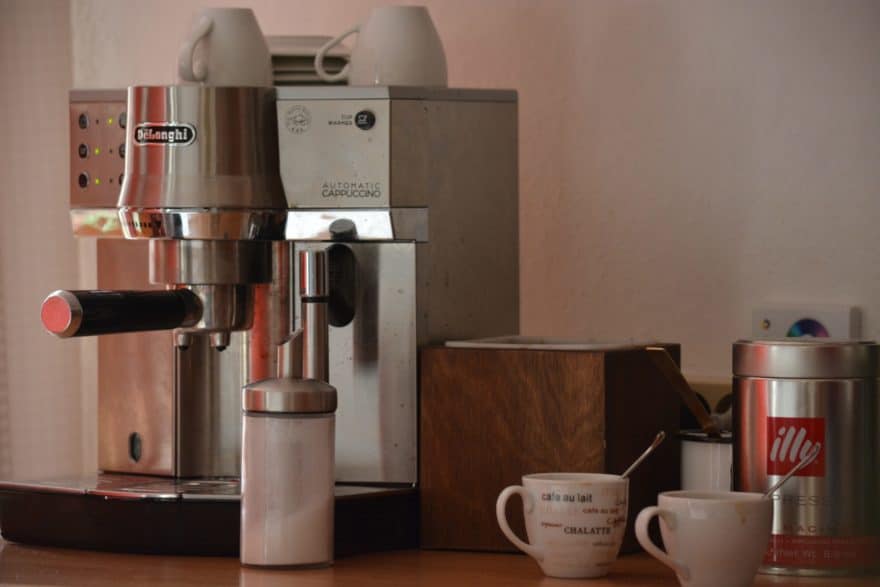
The good news is that there’s a machine in just about every size, so make sure to consider your spacing needs when picking out a machine.
Cup clearance
If a machine has low clearance beneath the portafilter spout, you may need dedicated espresso cups or short cappuccino cups. On many models, a removable or adjustable cup tray allows for taller cups.
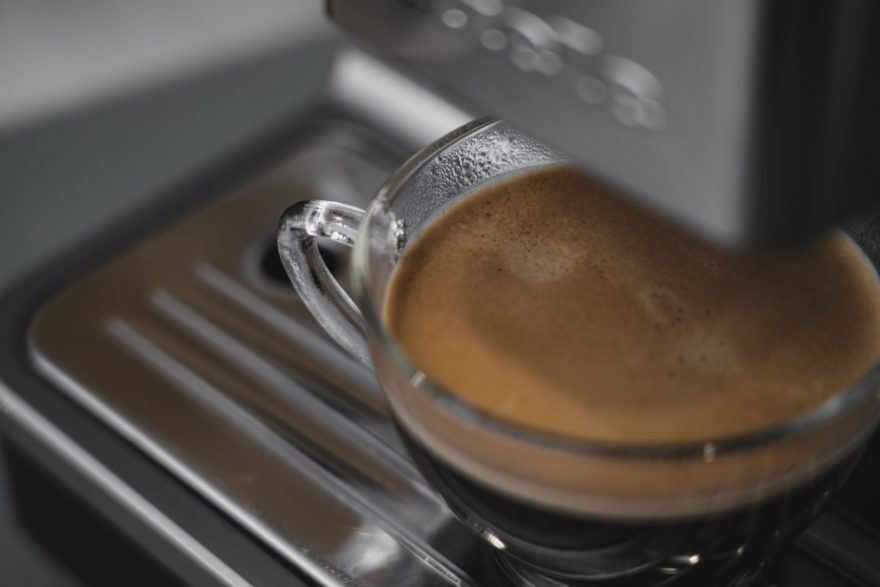
Steaming ability
If you’re interested in making latte or cappuccino, you need a machine that can produce the richly layered milk that goes into those drinks.
To steam milk, you need to raise the temperature of water to over boiling, but espresso is produced at sub-boiling temperatures. This means an espresso maker needs to operate at more than one temperature level.
Single-boiler machines can’t produce espresso shots while steaming milk at the same time. Double-boiler machines can do both simultaneously. Be aware of your requirements when it comes to steaming milk, and pick out a machine that can handle this.
Level of automation
When you’re starting out, it’s nice to have an espresso machine that can do some of the heavy lifting for you. Some espresso makers do just that, with a range of automated or pre-set routines programmed in to produce espresso or other drinks at the push of a button.
Other machines are far more bare-bones, asking you to do more of the setup work. When choosing your machine, consider the level of automation you’ll want for your day-to-day espresso brewing needs. And keep in mind that if there’s too much automation, you might outgrow it as you become more skilled.
Ease of cleaning
Cleaning your espresso machine is important for health reasons, but also to ensure it continues to operate properly and produces the best possible coffee. You must do some basic cleaning after each use, because it doesn’t take long for unpleasant odours and tastes to develop. Try to find a machine that makes this quick and easy.
Build quality
An espresso maker is a heavy-duty apparatus, and the process of making espresso is taxing. It involves high temperatures, high pressure, and constant exposure to water, all of which are hard on any machine.
All of the espresso makers we’ve covered are high-quality machines, capable of holding up to prolonged usage over months and years. But not all machines are built for the long haul. Make sure to research customer experiences to confirm that your potential espresso maker doesn’t have quality or durability issues.
Warranty
An espresso maker is a major investment, especially if you’re considering a higher-end machine. As such, it’s often a good idea to make sure you’re covered in case something goes wrong with your machine.
Most espresso machines offer warranties, so pick one that leaves you feeling secure about your purchase. Make sure to look into the warranty options and find one that matches your risk tolerance.
How does an espresso machine work?
The key to making espresso is pressure. Using pressurized water is what separates the process of making espresso from making regular coffee.
Regular coffee is produced by using gravity to drip hot water over ground coffee beans. Espresso, in contrast, channels pressurized water over coffee grounds over a shorter period of time. Additionally, when making espresso, you use finer ground beans than if making regular coffee.
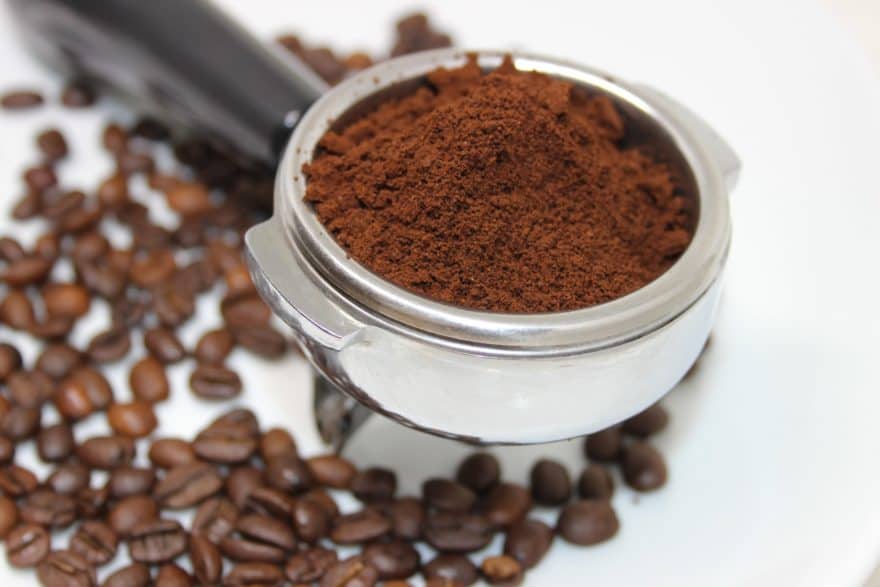
The two primary functions of an espresso maker are to heat and pressurize water. It starts with a water tank or water source, where the water begins. A pump then conveys that water at around 130 psi to the coffee grounds, while being heated by a boiler or other heat source. The water source, pressurized pump, and heat source are the three fundamental parts of any espresso maker.
The final piece of the espresso-making process is the portafilter, short for portable filter. The portafilter is what actually holds the coffee grounds, and the pump will direct water through the portafilter to create the espresso.
Finally, a steam wand or milk-steaming apparatus steams milk, which is then used for many coffee drinks like the latte or the cappuccino.
Home espresso FAQ
Which types of coffee beans work best with espresso machines?
Any coffee bean can be used to make espresso or regular coffee, but espresso uses around six times as much of the bean as regular brewing. This means the quality of the coffee beans can matter much more. The best espresso beans are flavorful Arabica beans and tend toward darker (or at least medium) roasts.
What drinks can you make with a home espresso machine?
An espresso maker is capable of producing a range of drinks, although the exact number will depend on the individual machine. Typically, an espresso maker can make a standard espresso, a double espresso, a cappuccino, a macchiato, and a latte.
Is a good grinder important for espresso?
Espresso requires a finer grind than regularly brewed coffee. Also, espresso coffee beans must be ground to exacting and consistent standards. Too fine a grind will produce unpleasantly bitter espresso, while too coarse a grind will create unduly weak espresso.
https://m.media-amazon.com/images/I/314IEgX+5tL.jpg
As such, a quality grinder capable of both the fineness required and a consistent standard of quality is essential.
What does tamping espresso mean?
To consistently produce excellent shots of espresso, it’s necessary to make sure the coffee grounds are tightly packed into the portafilter. After pouring loose grounds into the portafilter, a tamping tool can be used to compress the grounds, making them ready for the espresso brewing process.
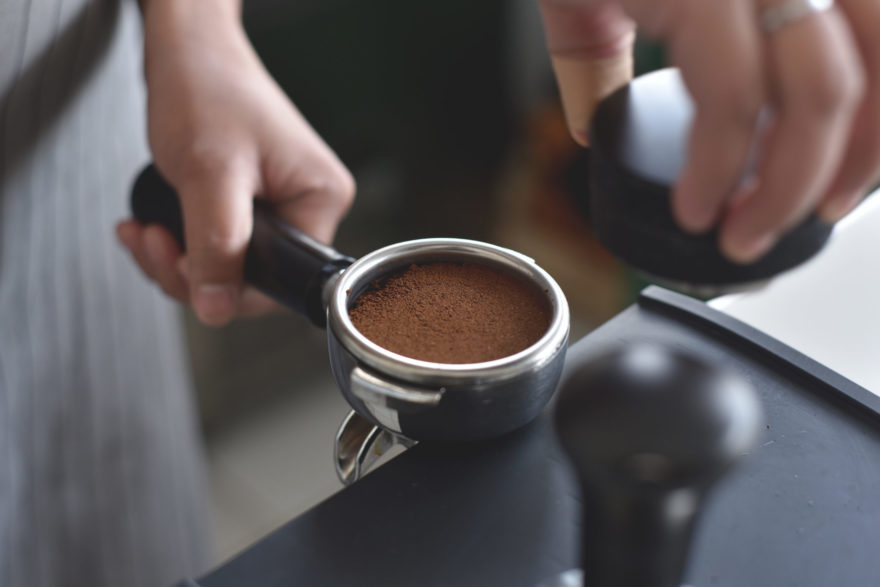
What is the ideal temperature and pressure for making espresso?
The ideal temperature when making espresso is in the range of 190-196 F. The ideal pressure level for making espresso is nine bars of pressure, or nine times the amount of pressure you normally find at sea level. This can be expressed as around 130 psi.
Do you need to descale an espresso machine?
Over time, minerals will build up in your espresso maker, eventually impacting the brewing process. You should descale your espresso maker every few months with a vinegar solution or special descaling solution.
Should I choose a pod machine?
Espresso pod machines are convenient. The drawback is that they limit your choice of coffees and don’t allow you to achieve great heights with your espresso. For you, the convenience factor might outweigh all other considerations, but if you’re looking for quality and variety then go with a non-pod machine.
What espresso machine does Starbucks use?
Most Starbucks stores use the Mastrena espresso machine. This machine is fully automated and can produce espresso from beans to cup. Mastrena partners with Starbucks in an exclusive arrangement, meaning their machines aren’t for home sale.
Image at top: © Guy Sie | Creative Commons

